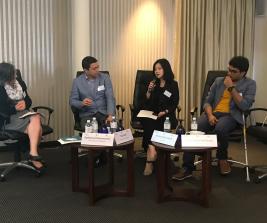What does the Fourth Industrial Revolution hold for Insurance?
Over the course of this year, the A2ii has worked with supervisors to understand better the unique regulatory challenges and opportunities of using mobile insurance.
However, we are seeing that the use of the mobile phone as a distribution channel or payment platform is not the only ‘technological innovation’ which is disrupting insurance markets but the introduction of other technological innovations such as peer-to-peer insurance, usage-based insurance and on-demand insurance are confronting supervisors with new questions. There are still only a few examples of how big data and data analytics are used in the inclusive insurance sphere, but this is another topic that might confront supervisors in the nearer future.
At the 13th International Microinsurance Conference, Stefanie Zinsmeyer of the A2ii facilitated a panel on mobile insurance and digital technologies and the role of the insurance supervisor. The panel provided an opportunity to discuss some of the potentials and challenges of these new technologies.
The Fourth Industrial Revolution
On the cusp of the Third Industrial Revolution where, as Jeremy Rifkin puts it markets become networks, ownership is access, and instead of sellers and buyers we now have providers and users, the talks of the Fourth Industrial Revolution emerge.
What is the Fourth Industrial Revolution? Professor Klaus Schwab, Founder and Executive Chairman of the World Economic Forum argues that it is the fusion of the physical, digital and biological worlds, impacting all disciplines, economies and industries.
Carlos Belloni, a renown strategic consultant in digital transformation and former COO for Zurich insurance for Latin America, talked about how the Fourth Industrial Revolution will disrupt the insurance industry: “The changes we will be facing in only three years will be gigantic. ” and asked if the industry and regulators where ready for this. Big data and new data analytics will allow for better insights into customer risk and will allow for better pricing and customer service. Carlos concluded that in the future insurance products will include less of a loss compensation element and more services designed to avoid or mitigate losses.
@A2ii_org @stzinsmeister @IntMicroinsConf @NetworkFlash - will I be unemployed soon or more productive as a microinsurance researcher? Can I insure against this risk? Will I still have health cover? Half joking half not! #4thindustrialrevolution #13thIMC pic.twitter.com/ZkJSp6H4Fi
— Jaco Weideman (@jaco_weideman) November 9, 2017
Challenges of Regulating Innovation
With Riovic, we had one of the often-cited InsurTech innovators on the panel. Riovic was founded in 2015 and is one of the first in South Africa to offer an on-demand insurance product. Founder and CEO Sicelo Phiwayinkosi Nkambule talked about the challenges faced by a non-insurance start-up trying to enter the insurance sphere and called on regulators to be open for innovation and to create a space to test and learn from innovation such as the sandbox approach.
We had the pleasure of being part of the 13th International Microinsurance Conference in Peru where we shared how we're disrupting insurance pic.twitter.com/fdxUImJCT4
— Riovic (@riovic_) November 18, 2017
Ghana is a pioneer in microinsurance in Sub Saharan Africa and 60% of this market is served through mobile insurance. Kofi Andoh from Ghana’s National Insurance Commission (NIC) shared lessons from Ghana’s experience with mobile insurance: a business model in evolution requires flexibility and proactive communication with the market to create the room for innovation. Important is to monitor market trends and understand the business models and risks. Ghana is one of the first countries that launched a mobile insurance regulation.
Future of InsurTech
Denise Garcia of Mexico’s supervisory authority CNSF shared the insights from the IAIS report on FinTech developments in the insurance industry. Three scenarios of how insurance value chains might develop in the future are identified in the report:
- Insurers successfully maintain the customer relationship;
- Fragmentation of the insurance value chain; insurers no longer in control;
- Big technology firms squeeze out traditional insurers;
The conclusion of the working group has been that although many scenarios exist for the future, it is too early to say what trends will materialise, but that FinTech developments are potentially disruptive. The analysis suggests that competitiveness is expected to reduce in the long term. Also, the ability of consumers to compare products between providers will become more difficult as segmentation of customers increases. Therefore, consumer choice will likely be reduced, and conduct of business risks will potentially increase. The risk of unauthorized access, use or transfer of personal data is expected to increase and data protection is another sensitive topic. The working group concludes that regulatory oversight will become more difficult.
The IAIS is currently also working on an Application paper on digital technologies in inclusive insurance. Peter van den Broeke from the IAIS Secretariat talked about some of the key aspects of that application paper and what support the IAIS is offering to supervisors. Peter pointed out some other challenges that supervisors are confronted with e.g. how new actors in the insurance value chain can be supervised and how digital technologies cut across multiple laws, regulations and authorities and how it creates the need for cooperation among different supervisors. Another challenge is the skills of the supervisors on IT issues e.g. to be able to understand underlying data analyses.
New digital technologies and greater availability of big data and new data analytics hold vast potential for improvements in product design and the development of better-tailored products and servicing of customers. However, this also comes with certain risks especially conduct of business risks. Greater availability of big data also comes with the risk of ‘financial exclusion’ whereby higher risk or less profitable consumers can be identified, and potentially excluded from being offered coverage in the first place or only offered it at prohibitively high prices. Supervisors have to strike a balance between facilitating innovation, increasing the inclusiveness of the insurance sector, and maintaining the conditions for a fair, safe and stable insurance sector for the benefit and protection of policyholders. Over the course of next year, the A2ii will focus on the topic of digital technologies during its Consultative Forums.







